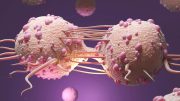
A new compound, discovered through extensive screening of 27 million potential drugs, has shown efficacy in reversing chronic pain in animal studies, with minimal side effects. This research represents a significant advancement in pain management. The compound, CBD3063, targets the Cav2.2 calcium channel in a novel way and has outperformed existing drugs like gabapentin. Ongoing research aims to refine this compound and bring it to clinical trials as a safer, more effective pain relief medication.
Researchers have discovered a small molecule capable of inhibiting four types of pain in preclinical studies.
A new study led by the Pain Research Center at NYU College of Dentistry, recently published in the Proceedings of the National Academy of Sciences (PNAS), has made a significant breakthrough in pain management. Researchers screened a library of 27 million potential new drugs, discovering a compound that effectively reversed four types of chronic pain in animal studies.
This small molecule works by binding to an inner region of a calcium channel, indirectly regulating it. Remarkably, it outperformed gabapentin, a commonly used pain medication, but without the associated troublesome side effects.
Calcium channels play a central role in pain signaling, in part through the release of neurotransmitters such as glutamate and GABA— “the currency of the pain signal,” according to Rajesh Khanna, director of the NYU Pain Research Center and professor of molecular pathobiology at NYU Dentistry. The Cav2.2 (or N-type) calcium channel is the target for three clinically available drugs, including gabapentin (sold under brand names including Neurontin) and pregabalin (Lyrica), which are widely used to treat nerve pain and epilepsy.
Gabapentin mitigates pain by binding to the outside of the Cav2.2 calcium channel, affecting the channel’s activity. However, like many pain medications, gabapentin use often comes with side effects.
“Developing effective pain management with minimal side effects is crucial, but creating new therapies has been challenging,” said Khanna, the senior author of the PNAS study. “Rather than directly going after known targets for pain relief, our lab is focused on indirectly targeting proteins that are involved in pain.”
Inside the channel
Khanna has long been interested in a protein called CRMP2, a key regulator of the Cav2.2 calcium channel that binds to the channel from the inside. He and his colleagues previously discovered a peptide (a small region of amino acids) derived from CRMP2 that could uncouple CRMP2 from the calcium channel. When this peptide—dubbed the calcium channel‐binding domain 3, or CBD3—was delivered to cells, it acted as a decoy, blocking CRMP2 from binding to the inside of the calcium channel. This resulted in less calcium entering the calcium channel and less neurotransmitter release, which translated to less pain in animal studies.
Peptides are difficult to synthesize as drugs because they are short-acting and easily degrade in the stomach, so the researchers sought to create a small molecule drug based on CBD3. Starting with the 15 amino acids that make up the CBD3 peptide, they honed in on two amino acids that studies showed were responsible for inhibiting calcium influx and mitigating pain.
“At that point, we realized that these two amino acids could be the building blocks for designing a small molecule,” said Khanna.
From 27 million to one
In collaboration with colleagues at the University of Pittsburgh, the researchers ran a computer simulation that screened a library of 27 million compounds to look for a small molecule that would “match” the CBD3 amino acids.
The simulation narrowed the library down to 77 compounds, which the researchers experimentally tested to see if they lessened the amount of calcium influx. This further pared the pool down to nine compounds, which were assessed using electrophysiology to measure decreases in electrical currents through the calcium channels.
One compound, which the researchers named CBD3063, emerged as the most promising candidate for treating pain. Biochemical tests revealed that CBD3063 disrupted the interaction between the CaV2.2 calcium channel and CRMP2 protein, reduced calcium entering the channel, and lessened the release of neurotransmitters.
“Many scientists have screened the same library of compounds, but have been trying to block the calcium channel from the outside. Our target, these two amino acids from CRMP2, is on the inside of the cell, and this indirect approach may be the key to our success,” said Khanna.
Four labs, four types of pain
Khanna’s lab then tested CBD3063 with mouse models for pain related to injury. The compound was effective in alleviating pain in both male and female mice—and notably, in a head-to-head test with the drug gabapentin, the researchers needed to use far less CBD3063 (1 to 10 mg) than gabapentin (30 mg) to reduce pain.
To explore whether CBD3063 helped with different types of chronic pain, Khanna partnered with researchers at Virginia Commonwealth University, Michigan State University, and Rutgers University. Collaborators ran similar studies administering CBD3063 to treat animal models of chemotherapy-induced neuropathy, inflammatory pain, and trigeminal nerve pain—all successfully reversing pain, similar to gabapentin.
But unlike gabapentin, the use of CBD3063 did not come with side effects, including sedation, changes to cognition such as memory and learning, or changes to heart rate and breathing.
What’s next
The researchers are continuing to study CBD3063, refining its chemical composition and running additional tests to study the compound’s safety and assess if tolerance develops.
In the long term, they hope to bring a CBD3063-derived drug to clinical trials in an effort to offer new options for safe and effective pain relief.
“Identifying this first-in-class small molecule has been the culmination of more than 15 years of research. Though our research journey continues, we aspire to present a superior successor to gabapentin for the effective management of chronic pain,” said Khanna.
Reference: “A peptidomimetic modulator of the CaV2.2 N-type calcium channel for chronic pain” by Kimberly Gomez, Ulises Santiago, Tyler S. Nelson, Heather N. Allen, Aida Calderon-Rivera, Sara Hestehave, Erick J. Rodríguez Palma, Yuan Zhou, Paz Duran, Santiago Loya-Lopez, Elaine Zhu, Upasana Kumar, Rory Shields, Eda Koseli, Bryan McKiver, Denise Giuvelis, Wanhong Zuo, Kufreobong E. Inyang, Angie Dorame, Aude Chefdeville, Dongzhi Ran, Samantha Perez-Miller, Yi Lu, Xia Liu, null Handoko, Paramjit S. Arora, Marcel Patek, Aubin Moutal, May Khanna, Huijuan Hu, Geoffroy Laumet, Tamara King, Jing Wang, M. Imad Damaj, Olga A. Korczeniewska, Carlos J. Camacho and Rajesh Khanna, 16 November 2023, Proceedings of the National Academy of Sciences.
DOI: 10.1073/pnas.2305215120
Additional authors include Kimberly Gomez, Tyler Nelson, Heather Allen, Aida Calderon-Rivera, Sara Hestehave, Erick Rodríguez Palma, Paz Duran, Santiago Loya-Lopez, Samantha Perez-Miller, and May Khanna of NYU Dentistry’s Pain Research Center; Elaine Zhu and Jing Wang of NYU Grossman School of Medicine; Handoko and Paramjit Arora of NYU’s Department of Chemistry; Ulises Santiago and Carlos Camacho of the University of Pittsburgh; Yuan Zhou, Angie Dorame, and Aude Chefdeville of the University of Arizona; Upasana Kumar, Rory Shields, Wanhong Zuo, Huijuan Hu, and Olga Korczeniewska of Rutgers University; Eda Koseli, Bryan McKiver, and M. Imad Damaj of Virginia Commonwealth University; Denise Giuvelis and Tamara King of the University of New England; Kufreobong Inyang and Geoffroy Laumet of Michigan State University; Dongzhi Ran, Yi Lu, and Xia Liu of Chongqing Medical University; Marcel Patek of Bright Rock Path LLC; and Aubin Moutal of St. Louis University.
The research labs are supported in part by the National Institutes of Health.









A new painkiller? In a month Mexican drug cartels will have it on the streets of Atlanta.
Good job!
The Cartels have PhD chemists on the payroll that can create analogs based on existing drugs. Small tweaks to the molecule’s quaternary (3D) structure can be tested on willing (or unwilling) subjects for efficacy. Obviously, their efforts are not restrained by our FDA.
I sincerely hope you were being facetious.
Great news, My wife suffers from peripheral neuropathy and has limited effect from gabapentin, if this proves viable she may be able to have relief, the pain is excruciating and she is very close to being bedridden.
Ketamine infusion has been shown to reroute nerve connections and provide relief from chronic pain. It is not an opioid and a series of treatments can provide lasting relief. Hope this helps and I hope your wife finds help for her pain soon.
As and aside, ketamine has been shown to alleviate symptoms of depression and anxiety as well. I don’t know anyone with chronic pain that does not also have depression and anxiety. Again, I really hope this helps